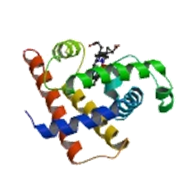BDBM50239866 CHEMBL4065018
SMILES O=C1Nc2cc(=O)n(Cc3ccccc3)cc2CN1c1cccc(OCc2ccccc2)c1
InChI Key InChIKey=BHMKGMWMMMZMJN-UHFFFAOYSA-N
Activity Spreadsheet -- Enzyme Inhibition Constant Data from BindingDB
 Found 4 hits for monomerid = 50239866
Found 4 hits for monomerid = 50239866
TargetU5 small nuclear ribonucleoprotein 200 kDa helicase(Homo sapiens (Human))
Takeda California
Curated by ChEMBL
Takeda California
Curated by ChEMBL
Affinity DataIC50: 790nMAssay Description:Inhibition of full length recombinant human N-terminal His-tagged BRR2 RNA dependent ATPase activity expressed in baculovirus infected Sf9 cells usin...More data for this Ligand-Target Pair
Affinity DataIC50: >1.00E+5nMAssay Description:Inhibition of eIF4G-induced full length recombinant human N-terminal His6/SUMO-tagged eIF4A1 RNA dependent ATPase activity expressed in Escherichia c...More data for this Ligand-Target Pair
Affinity DataIC50: >1.00E+5nMAssay Description:Inhibition of full length recombinant human N-terminal FLAG-His-tagged DHX29 RNA dependent ATPase activity expressed in baculovirus infected Sf9 inse...More data for this Ligand-Target Pair
Affinity DataIC50: >1.00E+5nMAssay Description:Inhibition of MLN51-induced full length recombinant human N-terminal His6/SUMO-tagged eIF4A3 RNA dependent ATPase activity expressed in Escherichia c...More data for this Ligand-Target Pair

 3D Structure (crystal)
3D Structure (crystal)